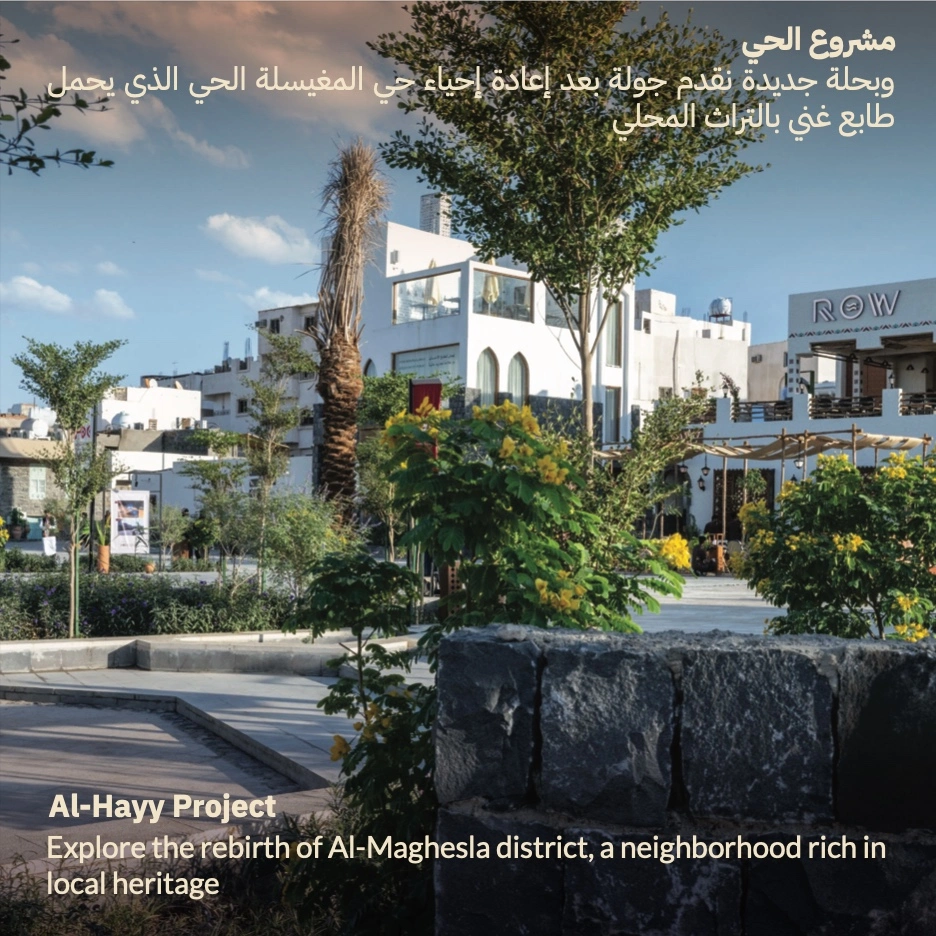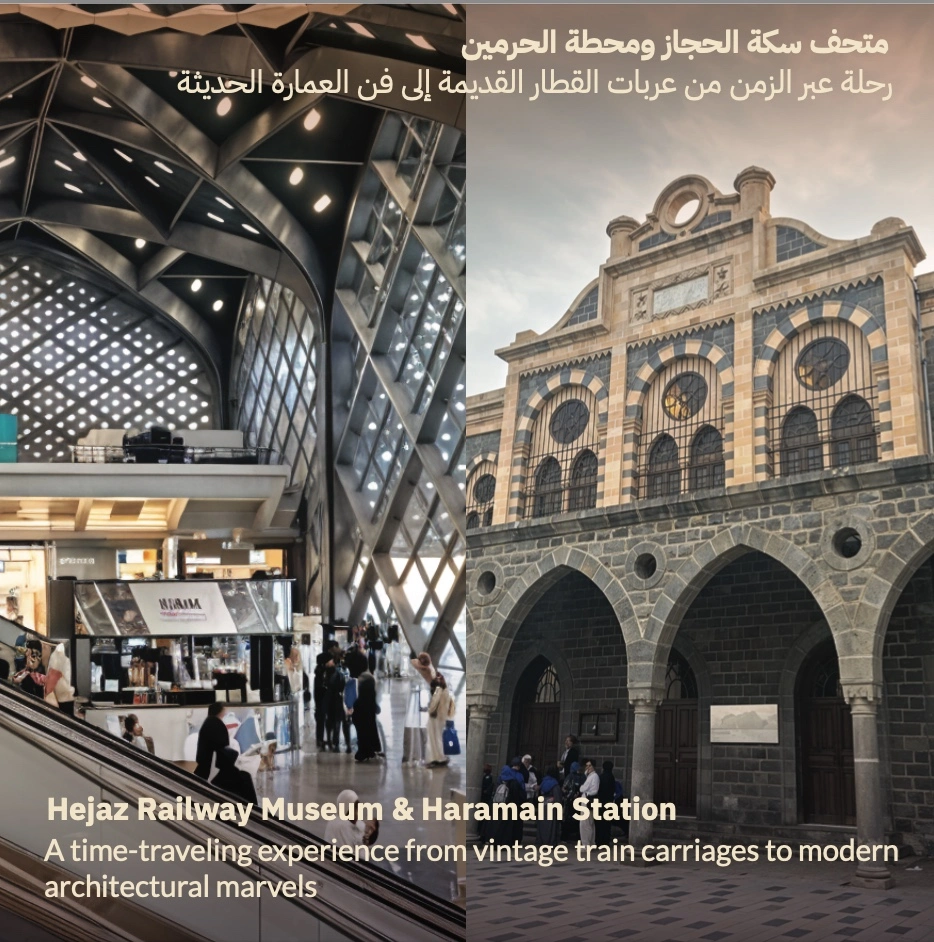In Medina, landmarks are not merely seen,they are deeply felt. In every corner, ancient spirits echo through the call to prayer, and the sun bows to walls that have endured centuries. The History of Medina is not just a tale of buildings but a living memory etched into the land itself. Through its stones, the prayers of passersby and whispers of history still linger. This city is not traversed merely by walking between structures, but by standing before monuments that speak of wisdom, identity, and grace.

Discover the History of Medina through Iconic Landmarks: Al-Hayy Project, Municipal Building, Hejaz Railway Museum, and Al-Anbariya Mosque
To understand the architectural development rooted in the History of Medina, one must observe its most prominent structures that blend functional utility with aesthetic identity.
- The Al-Hayy Project: represents a modern interpretation of traditional Hijazi architecture. Featuring both residential and commercial buildings, it integrates classic elements like mashrabiya-style windows and locally colored stone blocks, while applying contemporary urban planning that caters to both residents and visitors.
- The Municipal Building of Medina: is another striking example, designed to reflect transparency and administrative order. Wide corridors, tall windows, and natural ventilation highlight its functional focus, while Islamic arches and geometric decorations unify beauty with efficiency.
- The Hejaz Railway Museum: preserves the architectural heritage of Ottoman-era service buildings. Its long corridors, arched doors, and wooden ceilings emphasize how Ottoman design adapted to modern needs like exhibitions and education while preserving authenticity.
- Al-Anbariya Mosque: exemplifies Ottoman religious architecture in the Hijazi context. With upper air vents and local stone usage, its design reflects smart adaptation to the hot climate. Natural lighting in its prayer hall is a testament to environmental awareness in spiritual spaces.
Each of these locations contributes to Medina’s modern urban fabric, merging local character with everyday functionality—a living part of the History of Medina.
Al-Safiya Museum and Orchard: (Blending Education, Culture, and Leisure)
- The Al-Safiya Museum and Orchard: serves as a contemporary model of how the History of Medina continues to influence cultural and educational development. Located in one integrated site, the project embodies modern cultural tourism with multiple functions. At its heart is the Museum of Creation, a center designed for interactive learning using digital displays and controlled lighting. The interior architecture promotes fluid visitor movement, offering pathways for contemplation, reading, or interacting with digital exhibits.
- The surrounding public garden: is not only beautiful but functionally urban. It includes shaded seating, well-paved walkways, and strategically placed vegetation and water elements to enhance climate comfort and air quality.
- Souvenir shops complement : the experience by offering
- Miniature architectural models.
- Handmade crafts.
- Documentation on the History of Medina.
- Customizable heritage gifts.
- Surrounding restaurants and cafés: are styled with traditional wood carvings, ambient lighting, and locally inspired furnishings. They provide a relaxing space suitable for families, educational groups, and independent travelers alike.
Together, these integrated spaces showcase how architecture in Medina evolves into a multi-use urban destination that fuses learning, leisure, and tradition.
Mosque Trail: Sacred Serenity in the Heart of the City
No exploration of the History of Medina is complete without walking through its mosques ,spiritual and architectural masterpieces. We begin with the:
- Medina Mosque, the Prophet’s Mosque, where majesty and elegance combine. Its green domes rise harmoniously over white marble floors, and its minarets seem like gateways to peace.
- Masjid Al-Ghamama, near the Prophet’s Mosque, is deeply tied to the Prophet’s biography. Its humble design, devoid of elaborate ornamentation, reflects the essence of true beauty meaning over form. With its white walls, wooden ceiling, and modest arches, it resembles traditional homes.
- Abu Bakr Al-Siddiq Mosque revives the intimate link between man and place. Its windows open to the memory of migration, and its stones echo the wisdom and companionship of the Prophet’s closest friend.
- Ali ibn Abi Talib Mosque radiates both strength and serenity. Its structure feels grounded in justice and courage. Meanwhile, Omar ibn Al-Khattab Mosque appears like a miniature fortress from the outside and a haven of discipline from the inside.
Each of these represents a unique architectural school. Together, they feed into the great river of the History of Medina, where design is a spiritual and communal journey.
Seerah Exhibition: Where Memory Becomes Reality!
Located strategically on Quba Street near Quba Mosque, the Seerah Exhibition transforms the story of the Prophet into a multi-sensory journey. Designed as a knowledge hub, it caters to diverse cultural and educational backgrounds by merging architecture with interactive technology.
The exhibition uses:
- Augmented reality and 3D simulations to recreate scenes from the Prophet’s life
- Functionally designed walkways that guide visitors through historical timelines
- Symbolic architectural elements like curved arches and focused lighting that visually narrate the story
Nearby stands Quba Fortress, restored to retain its defensive architectural features while offering interpretive displays to help visitors understand its strategic function.
Quba Mosque itself is more than a place of worship. It demonstrates how sacred architecture serves multiple roles—guidance, education, community building. It features modern facilities like waiting areas, digital multilingual signboards, and updated sanitation facilities—all while preserving spiritual authenticity.
This harmonious interplay of form and function embodies how the History of Medina continues to adapt and inspire.

Traditional Residential Architecture: Earthen Homes and Mashrabiya Windows
While mosques and museums draw the eye, the traditional homes in old Medina neighborhoods are architectural gems that reflect lifestyle and environment. These structures aren’t just shelters—they are deeply rooted in the philosophy of privacy, natural ventilation, and desert adaptation.
Key features of residential architecture in the History of Medina include:
- Palm-trunk ceilings offering warmth in winter and coolness in summer
- Mashrabiya windows that filter light while ensuring privacy
- Internal courtyards used for gathering, hosting, or gardening
- Decorative plaster and wood carvings bearing spiritual or aesthetic motifs
These homes breathe, live, and express a lifestyle aligned with nature and community. They prove that Medina’s architectural story is more than visual; it’s a way of life.
For enthusiasts, explore our guide:
Discover Saudi Arabia cultural tours with Archinations, a curated journey through regional design philosophies rooted in the History of Medina.
Sustainability in Prophetic and Contemporary Architecture
Long before sustainability became a global concern, the History of Medina had already embodied it. Since the Prophet’s time, buildings were crafted to respect both people and the environment, a concept reflected in many of today’s urban projects.
Key sustainable practices in Medina’s architectural evolution include:
- Using local materials like Medina clay and stone
- Maximizing natural light with large windows and open-roof lighting
- Designing shaded walkways (riwaq) in mosques and markets to reduce sun exposure
- Restoring heritage buildings rather than demolishing them, as seen in Quba Center and Al-Manakha Market
- Incorporating solar energy in newer projects, especially in exhibitions and museums
Here, sustainability flows from heritage—it’s not a trend but a continuation of core values embedded in the History of Medina.
Archinations Tours: Where Architecture Becomes a Living Story
Today, visiting Medina is more than just a sightseeing activity; it’s a soulful immersion enabled by initiatives like Archinations. This platform goes beyond logistics to offer profound architectural experiences.
Through expert-led field tours, Archinations allows participants to:
- Engage with local specialists offering unique narratives.
- Access off-the-beaten-path landmarks.
- Experience audio-visual storytelling enhanced by technology.
- Understand the religious and social contexts behind each structure.
This isn’t your average tourist brochure. It’s a transformative journey that redefines the History of Medina as a lens through which visitors discover themselves, their faith, and the essence of place. Book your trip now with the Madina Tour.
Between the Visitor and the City: Architecture as Spiritual Experience
In Medina, architecture transcends the visual; it touches the soul. Anyone who walks its sacred ground feels that beauty here is not decorative, but deeply meaningful. The alignment of buildings, the harmony of forms, the humble intricacies they all awaken serenity and focus.
When one walks through the Medina Mosque, or touches the cool stone of Quba Mosque at dawn, it becomes clear: the History of Medina is not about walls, but about connection. It is about stillness, reflection, and the timeless dialogue between the heart and the sacred.
When Eyes See Beyond Walls
The History of Medina is more than a style, it’s a feeling. It’s the scent of clay houses, the warmth of century-old wooden doors, the echo beneath a mosque’s arch at daybreak. Every corner carries a story, every wall whispers wisdom, and every minaret prays that time may slow. For those seeking beauty in depth, quiet in majesty, and legacy in design, Medina opens its heart ,and its stones.
FAQs
What architectural style dominates Medina?
Traditional Hijazi architecture blended with Ottoman and Islamic classical elements.
Are there non-religious historical buildings in Medina?
Yes, such as the Hejaz Railway Station, Ottoman forts, and historical palaces.
What is the architectural significance of Quba Mosque?
It is the first mosque in Islam, celebrated for its simplicity and spiritual design.
What are the defining features of Islamic architecture in Medina?
Domes, arches, slender minarets, and floral/geometric decorations.
Are modern restoration techniques used in Medina?
Yes, advanced methods are employed to preserve heritage while upgrading infrastructure.
Can architectural sites be visited through tours?
Yes, Archinations offers specialized tours to explore such landmarks.
Is Medina’s architecture adapted to desert climate?
Absolutely—through insulating materials, shaded paths, and inner courtyards.
Are there urban development projects in the city?
Yes, including Al-Hayy Project, Quba Center, the northern facade of the Prophet’s Mosque, Rua Al-Madinah, Knowledge Gate, and Dar Al-Hijrah.
What is a standout modern architectural site in Medina?
The Seerah Exhibition stands out as one of the city’s most innovative recent developments.
